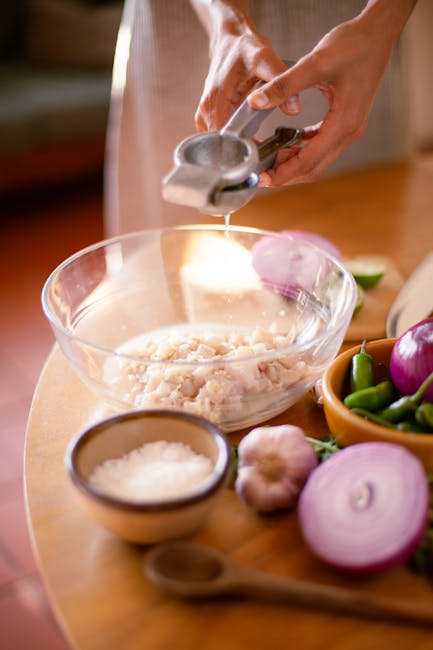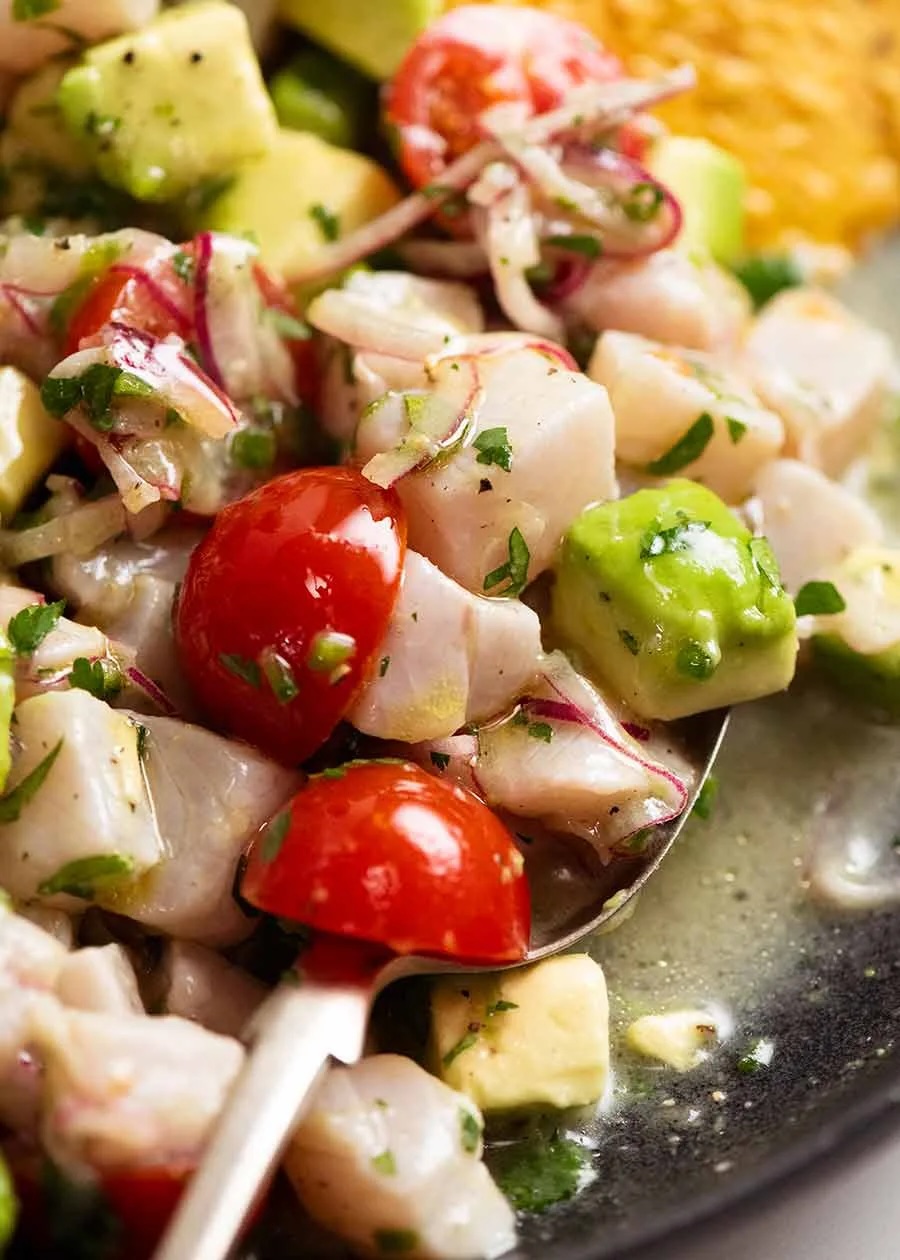Imagine a dish bursting with fresh, zesty flavors that dances on your tongue. That’s ceviche! More than just food, it’s an experience, a culinary journey to the coasts of Latin America. Let’s dive into the world of ceviche, exploring its origins, ingredients, and the secrets to making it perfectly.
What Exactly is Ceviche?
 A vibrant, close-up shot of a bowl of beautifully prepared ceviche with visible pieces of fish, onions, cilantro, and citrus.
A vibrant, close-up shot of a bowl of beautifully prepared ceviche with visible pieces of fish, onions, cilantro, and citrus.
At its core, ceviche (pronounced seh-VEE-chay) is a seafood dish, typically made with fresh raw fish cured in citrus juices, most commonly lime or lemon. The acidity of the citrus “cooks” the fish, denaturing its proteins and giving it a firm texture. It’s then seasoned with ingredients like onions, cilantro, and chili peppers. Think of it as a refreshing explosion of flavors that awaken the palate. You might also see it spelled “cebiche” or “seviche” – it just depends on the region!
A History Steeped in the Sea
 A historical illustration or photograph depicting ancient peoples preparing or enjoying seafood dishes, perhaps with citrus fruits.
A historical illustration or photograph depicting ancient peoples preparing or enjoying seafood dishes, perhaps with citrus fruits.
The history of ceviche is as fascinating as the dish itself. While its exact origins are debated, most food historians trace it back to ancient civilizations in Peru. The Moche culture, which thrived along the Peruvian coast centuries ago, is believed to have marinated fish in fermented fruit juices. Over time, as lemons and limes were introduced, the recipe evolved into the ceviche we know and love today. It’s become a symbol of Peruvian cuisine and a beloved dish throughout Latin America.
Ceviche’s Journey Through Time
 A timeline graphic showcasing the evolution of ceviche from ancient Peruvian cultures to modern variations.
A timeline graphic showcasing the evolution of ceviche from ancient Peruvian cultures to modern variations.
- Ancient Peru: Marinating fish in fermented fruit juices.
- Arrival of Citrus: The addition of lemons and limes transformed the dish.
- Regional Variations: Each country adds its unique twist, from Mexico’s tomato-based ceviche to Ecuador’s shrimp ceviche.
The Key Ingredients: Freshness is King
 A collage of fresh ingredients commonly used in ceviche, including fish, limes, red onion, cilantro, and chili peppers.
A collage of fresh ingredients commonly used in ceviche, including fish, limes, red onion, cilantro, and chili peppers.
The quality of your ceviche hinges on the freshness of its ingredients. You absolutely need the freshest fish you can find. Here’s a breakdown of the essentials:
The Fish: Choosing Wisely
 A display of various types of fresh fish that are suitable for making ceviche, such as sea bass, flounder, and snapper.
A display of various types of fresh fish that are suitable for making ceviche, such as sea bass, flounder, and snapper.
- Types of Fish: Sea bass, flounder, snapper, and halibut are excellent choices. Look for firm, clear flesh and a fresh, sea-like smell.
- Sustainable Sourcing: Choose fish that is sustainably sourced to protect our oceans. Seafood Watch is a great resource.
- Safety First: Ensure the fish has been properly handled and stored to minimize the risk of foodborne illness.
The Citrus: The Heart of the Cure
 A close-up shot of freshly squeezed lime juice being poured over raw fish.
A close-up shot of freshly squeezed lime juice being poured over raw fish.
Lime juice is the traditional choice, but lemon juice can also be used. The citrus “cooks” the fish, giving it that characteristic firm texture. Freshly squeezed juice is a must!
The Aromatics: Adding Depth of Flavor
 A selection of aromatics like red onion, cilantro, chili peppers, and ginger, used to enhance the flavor of ceviche.
A selection of aromatics like red onion, cilantro, chili peppers, and ginger, used to enhance the flavor of ceviche.
- Red Onion: Adds a sharp, pungent bite. Soak it in ice water to mellow the flavor.
- Cilantro: Provides a fresh, herbaceous note.
- Chili Peppers: Offer a touch of heat. Adjust the amount to your preference.
Making Ceviche: A Step-by-Step Guide
 A series of images showing each step of the ceviche-making process, from chopping the ingredients to marinating the fish.
A series of images showing each step of the ceviche-making process, from chopping the ingredients to marinating the fish.
Making ceviche is surprisingly simple! Here’s a basic recipe to get you started:
- Prepare the Fish: Cut the fish into small, bite-sized pieces.
- Marinate: Place the fish in a non-reactive bowl (glass or ceramic) and cover with freshly squeezed lime juice. Ensure the fish is completely submerged.
- Refrigerate: Cover the bowl and refrigerate for 15-30 minutes, depending on the thickness of the fish and your preference for texture. The longer it marinates, the firmer it will become.
- Add Aromatics: Mix in finely chopped red onion, cilantro, and chili peppers.
- Season: Season with salt and pepper to taste.
- Serve: Serve immediately with sides like plantain chips, sweet potato, or lettuce cups.
Regional Variations: A World of Ceviche
 A collage featuring different regional variations of ceviche from various Latin American countries.
A collage featuring different regional variations of ceviche from various Latin American countries.
Ceviche isn’t just one dish; it’s a family of dishes, each with its own regional twist. Here are a few examples:
Peruvian Ceviche
 A picture of classic Peruvian ceviche, showcasing its clean and simple presentation.
A picture of classic Peruvian ceviche, showcasing its clean and simple presentation.
Often served with leche de tigre (the leftover citrus marinade), sweet potato, and cancha (toasted corn).
Mexican Ceviche
 A picture of Mexican ceviche, often featuring tomatoes, avocado, and jalapeños.
A picture of Mexican ceviche, often featuring tomatoes, avocado, and jalapeños.
Commonly includes tomatoes, avocado, and jalapeños. Often served with tostadas or tortilla chips.
Ecuadorian Ceviche
 A picture of Ecuadorian ceviche, often featuring shrimp and served with popcorn or plantain chips.
A picture of Ecuadorian ceviche, often featuring shrimp and served with popcorn or plantain chips.
Often made with shrimp and served with popcorn or plantain chips.
Conclusion
 A final, appealing shot of a plate of ceviche, inviting the reader to try it themselves.
A final, appealing shot of a plate of ceviche, inviting the reader to try it themselves.
Ceviche is more than just a recipe; it’s a celebration of fresh, vibrant flavors and a testament to the culinary ingenuity of Latin America. From the ancient marinating techniques to the modern variations we enjoy today, ceviche offers a unique and refreshing culinary experience. So, grab some fresh fish, squeeze those limes, and embark on your own ceviche adventure! And remember to always prioritize food safety by sourcing the freshest ingredients possible.
